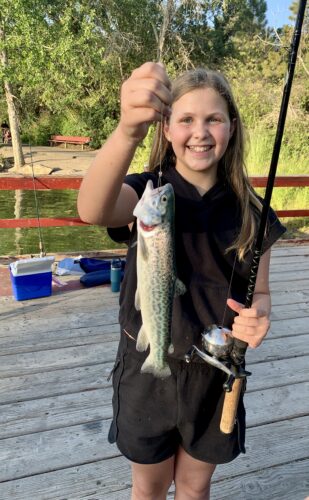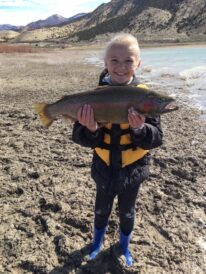Tips for catch-and-release fishing during hot summer months

This young angler visited Highland Glen Park Pond …released 19 fish, including this tiger trout.
As excessive heat warnings blanket much of Utah, many residents are seeking relief at nearby lakes or mountain areas. If your summer plans include fishing, here are some crucial tips to reduce stress on the fish and improve their chances of survival if you plan to release them.
1. Fish During Cooler Times: Aim to fish in the early mornings or late evenings when temperatures are cooler. If fishing in a river, choose spots with deeper, cooler water to release any caught fish, enhancing their chances of survival.
2. Be Aware of Barotrauma: Fish caught in deep water reservoirs may suffer from barotrauma, or pressure damage, when brought up too quickly from the cooler depths to the hot surface. In such conditions, consider harvesting the fish as part of your daily limit instead of releasing it. Barotrauma recovery can be challenging for fish. More details on barotrauma and its effects on different fish species can be found on the DWR website.
3. Choose Release Spots Wisely: “Be mindful of where you fish and release fish,” advised Trina Hedrick, Sportfish Coordinator for the Utah Division of Wildlife Resources. “Select spots with better quality water to increase fish survival rates during extreme heat.”
4. Use Proper Equipment: When fishing in hot weather, use appropriately sized equipment to reduce stress on the fish. “Lighter equipment is fun, but it prolongs the fight, increasing stress,” Hedrick said. “Keep the fish in the water as much as possible, minimize handling time, and release it quickly. Using a rubber mesh net and removing the hook while the fish is in the water is ideal. Avoid taking the fish out of the water for pictures if you plan to release it.”
Additional tips for hot weather catch-and-release fishing:
- Use Single Hooks: Employ single hooks on lures and bend down the barbs for easier release.
- Minimize Fight Time: Reduce the time spent reeling in the fish to lower stress levels.
- Handle Fish Minimally: Handling can cause the loss of the slime coat and scales, leading to infection. Always wet your hands before touching the fish.
- Limit Air Exposure: Keep the fish out of the air as briefly as possible, especially in hot weather. If using a net, keep the fish in the water while removing the hook.
- Use Protective Nets: Rubber or coated nylon nets help preserve a fish’s slime layer and fins.
- Quickly Remove Hooks: Use forceps or needle-nosed pliers to swiftly remove hooks. If the fish is deeply hooked, cut the line close to where it’s hooked and leave the hook.
- Allow Recovery: Let the fish recover in the net before releasing it. If the fish doesn’t stay upright upon release, gently move it back and forth. If it cannot recover, consider keeping it as part of your daily limit.
By following these guidelines, anglers can enjoy their fishing trips while ensuring the well-being of the fish and maintaining healthy fish populations.



